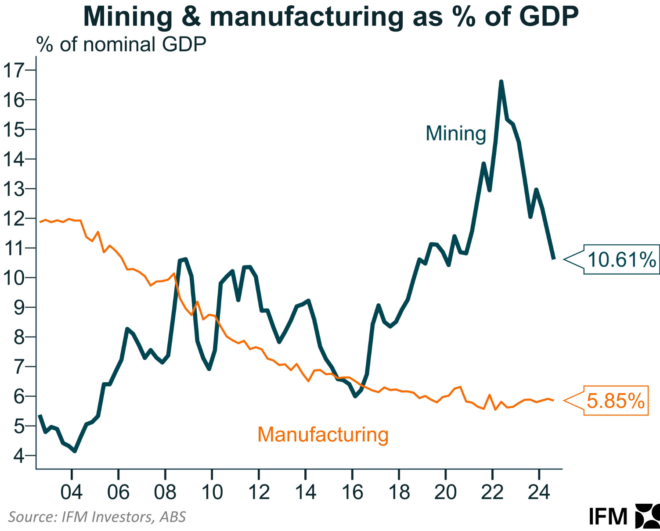Australia’s manufacturing sector bogged deep in recession

Australia's manufacturing sector has been in terminal decline for 40 years, with the sector's share of GDP declining by nearly two-thirds since the late 1970s.

As a result, Australia now has the lowest manufacturing share in the OECD.

The net zero heroes will probably be happy with this outcome given that the manufacturing sector's share of energy use (and emissions) has fallen alongside its output.

By contrast, the mining sector has roughly doubled its share of GDP over the same period, which has seen its energy use overtake the manufacturing sector.

The reality is that Australia has merely exported its manufacturing capacity to China, which is burning our energy and creating vast emissions instead.

The latest S&P Global Australia Manufacturing PMI remains stuck in recession, suggesting that Australia's manufacturing sector continues to shrink.

The headline seasonally adjusted S&P Global Australia Manufacturing Purchasing Manager’s Index™ (PMI®) posted 47.8 in December, down from 49.4 in November. This indicated an eleventh successive monthly deterioration of manufacturing conditions and at a pace more pronounced than in November.
"Australia’s manufacturing sector conditions deteriorated at a more pronounced pace in the closing month of 2024", S&P Global noted. "Quicker reductions in both overall and export orders led to a deepening of manufacturing output contraction".
"In turn, capacity pressures eased and job shedding renewed. Firms also reduced their purchasing activity and inventory holdings".
"According to panellists, higher input material, energy and shipping costs contributed to the latest uptick in average input prices".
"The rate of output price inflation climbed to the highest since October but remained below the long-run average", S&P Global said.

The longer-term reality is that Australia's manufacturing sector will contract so long as gas and electricity prices continue to rise.
Australia's manufacturing sector once enjoyed some of the lowest-cost energy in the world, providing it with a competitive advantage over other nations.
But decades of compounding energy policy failure have seen Australian manufacturers pay exorbitant prices for gas and electricity, despite the country's massive gas and coal resources and major exports of both.
East Coast gas and electricity prices are facing further escalation as LNG import terminals are constructed in NSW and Victoria, locking in permanently higher prices.
Australia has no manufacturing future without reliable and affordable energy.
A nation so utterly dependent on others for manufactured goods is not a serious country.







